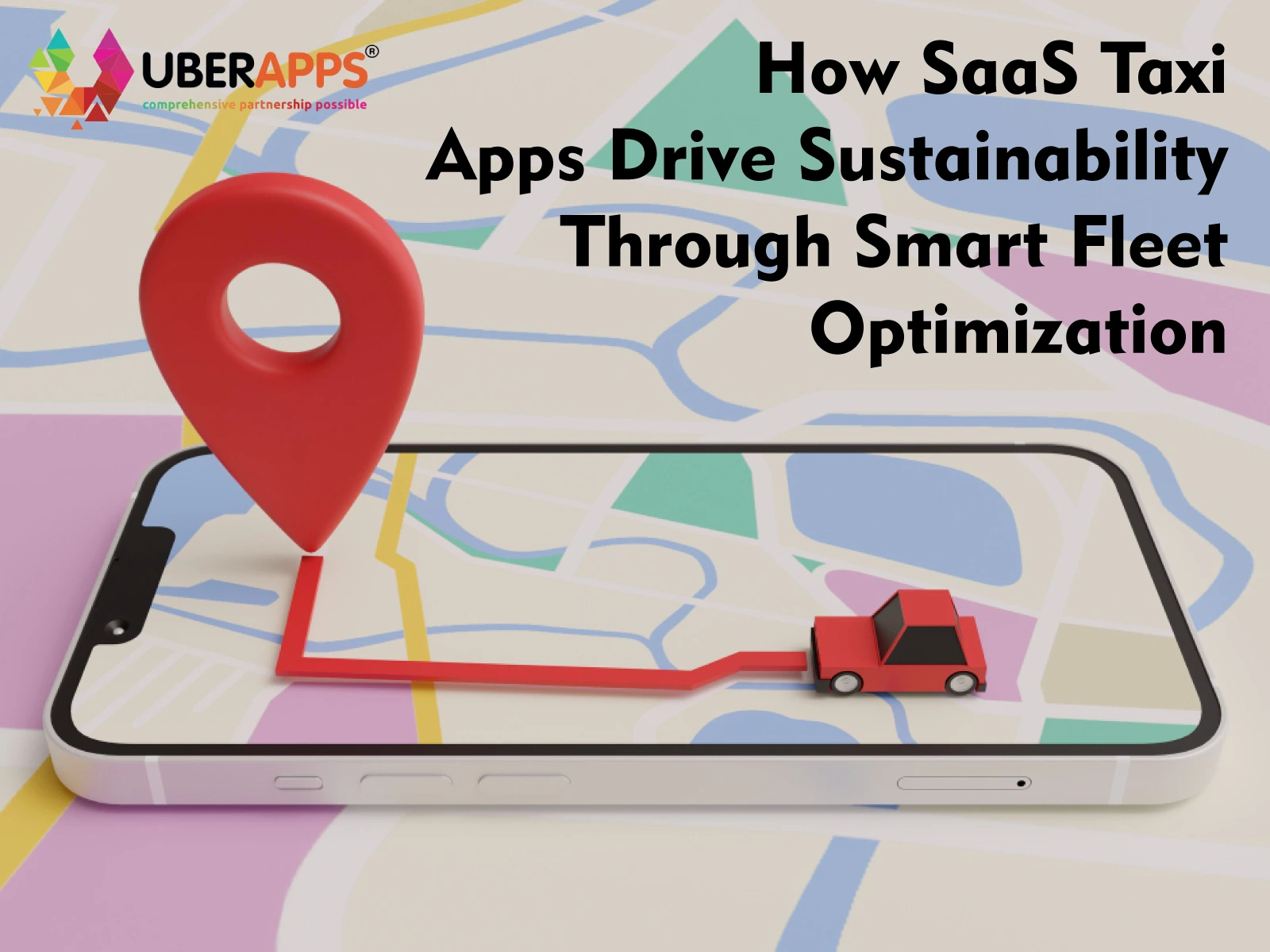
How SaaS Taxi Apps Drive Sustainability Through Smart Fleet Optimization
Sustainability is no longer a luxury—it’s a competitive advantage. Cities around the world are enforcing stricter emission standards, while customers are increasingly choosing eco-friendly ride options.
In this changing landscape, SaaS-based taxi apps are redefining fleet management through smart optimization.
Unlike traditional systems, SaaS taxi platforms combine AI analytics, cloud scalability, and automation to create greener, more efficient taxi operations. By minimizing fuel waste and maximizing fleet utilization, these platforms help companies cut both costs and carbon footprints.
As cities push toward greener transportation, SaaS-based taxi apps are transforming how fleets operate. Instead of relying on manual dispatch and inefficient routing, modern AI-powered taxi booking apps optimize every mile—cutting fuel use, idle time, and emissions. Through cloud automation, real-time analytics, and smart algorithms, ride-hailing companies now achieve both profitability and sustainability. This blog explores how SaaS taxi app platforms are enabling eco-friendly operations—from predictive fleet scheduling and EV adoption to driver behavior insights and carbon-tracking dashboards. Whether you’re a startup or an established operator, you’ll see how embracing SaaS taxi app development can future-proof your business and align it with global sustainability goals.
1 The Role of SaaS Taxi Apps in Sustainable Mobility
Cloud-Based Efficiency
A SaaS taxi app runs entirely on the cloud, which eliminates the need for heavy local infrastructure. This reduces energy usage and allows seamless updates, scaling, and monitoring—essential for sustainability.
Data-Driven Decision-Making
Through centralized dashboards, taxi operators gain access to:
- Real-time driver performance
- Fuel consumption patterns
- Route efficiency metrics
This visibility empowers businesses to make eco-conscious, data-backed decisions.
Key takeaway: SaaS platforms enable operators to achieve efficiency at scale without increasing their environmental footprint.
2 Smart Fleet Optimization: The Heart of Green Mobility
AI in Taxi App Operations
Artificial intelligence plays a crucial role in fleet optimization. AI algorithms analyze rider demand, traffic data, and driver locations to dynamically assign rides.
Benefits
- Reduced idle time: Cars spend less time waiting for bookings.
- Lower emissions: Optimized routing means fewer kilometers per trip.
- Faster service: Riders get quicker pickups, improving satisfaction.
Example: A mid-sized fleet using AI dispatch can cut idle driving by 25%, saving thousands of liters of fuel annually.
Predictive Fleet Scheduling
SaaS taxi app development leverages machine learning to anticipate demand spikes. The system automatically allocates drivers where demand will rise airports, stadiums, or business districts.
Result:
- Fewer empty return trips
- Optimal driver distribution
- Reduced fuel wastage
Key takeaway: Predictive scheduling creates a win-win scenario lower operational costs and smaller carbon footprints.
Dynamic Route Optimization
Smart algorithms continuously monitor traffic conditions, roadblocks, and weather patterns. The ride-hailing app recalculates the most fuel-efficient routes in real-time.
Advantages
- 10–20% reduction in trip time
- Lower CO₂ emissions per ride
- Enhanced customer satisfaction
3 EV Integration Through SaaS Platforms
Supporting the Electric Fleet Transition
The world is shifting toward electric vehicles (EVs), and SaaS-based taxi apps are leading that transition.
Modern systems include:
- EV-specific dispatch logic (battery level, nearest charging station)
- Smart charging station mapping
- Energy consumption analytics
Case Example
A European mobility startup integrated EV support into its SaaS taxi system and reduced operational emissions by 40% within a year.
Key takeaway: SaaS taxi apps simplify EV adoption with plug-and-play modules for sustainable fleet transformation.
4 Driver Behavior Analytics: Building an Eco-Conscious Workforce
Real-Time Monitoring
AI-powered telematics in SaaS taxi apps track speed, braking, acceleration, and idle patterns.
Feedback & Rewards
Drivers receive feedback via the app, encouraging smoother, fuel-efficient driving habits. Top eco-performers can earn bonuses or badges.
Impact
- Improved driving behavior reduces fuel costs by 10–15%.
- Fewer harsh braking events lead to lower maintenance costs.
Key takeaway: Behavior analytics empower drivers to become active participants in sustainability.
5 Data Analytics: The Engine of Smart Taxi Operations
Fleet Performance Dashboards
Admin panels in SaaS taxi software provide instant KPIs:
- Average ride length
- Idle percentage
- Fuel usage trends
- CO₂ per kilometer
Predictive Maintenance
AI detects vehicle wear patterns before breakdowns occur. This reduces downtime, extends vehicle life, and prevents resource wastage.
Sustainability Reports
Companies can automatically generate monthly sustainability insights—ideal for investors and compliance reporting.
6 Automation for Energy Efficiency
Automation is one of the strongest advantages of a SaaS taxi platform.
Automated Dispatch & Pricing
Smart dispatch minimizes unnecessary detours. Dynamic pricing balances demand and supply—keeping fewer cars running empty.
Digital Invoicing & Paperless Operations
Transitioning to e-receipts and cloud accounting reduces paper waste while improving record-keeping accuracy.
Key takeaway: Automation drives both efficiency and environmental responsibility—core pillars of modern mobility businesses.
7 The Role of AI and IoT in Green Fleet Management
AI in Taxi App Development
AI powers:
- Route optimization
- Demand prediction
- Driver scoring systems
- Energy management for EVs
IoT Sensors
Connected sensors relay live vehicle health data—tire pressure, engine efficiency, and battery status—helping operators act before energy losses occur.
Example: IoT integration helped one operator reduce fuel leaks and mechanical inefficiencies, saving 8% on monthly fuel costs.
8 Reducing Carbon Emissions with SaaS Taxi Apps
Key Methods
- Route optimization lowers fuel burn.
- Shared ride pooling decreases total trips.
- EV support eliminates tailpipe emissions.
- Real-time analytics monitor CO₂ reduction in dashboards.
Carbon Tracking
The latest SaaS taxi app solutions display estimated CO₂ saved per trip—boosting brand image and encouraging riders to choose greener options.
9 User-Centric Sustainability: How Riders Benefit
Eco-Ride Choices
Passengers can choose “Green Ride” options—EV or hybrid vehicles—directly within the taxi booking app.
Transparency
The app displays environmental impact per ride, motivating conscious decisions.
Loyalty Integration
Eco-friendly riders can earn sustainability rewards, promoting retention and positive brand sentiment.
Key takeaway: Sustainability becomes a shared experience between business, driver, and rider.
10 Case Studies: SaaS Taxi Apps Going Green
Bolt Green (Europe)
- Introduced a “Green” ride category via SaaS updates.
- Achieved 15% emission reduction in major cities.
Grab (Southeast Asia)
- Leveraged AI in taxi app modules for EV route planning.
- Partnered with renewable-energy charging stations.
Dymond Fleets (Nigeria)
- Implemented Appicial’s SaaS taxi platform with smart route tracking and performance analytics.
- Reduced idle drive time by 30% while promoting clean mobility.
Key takeaway: Global and local players alike rely on SaaS flexibility to execute sustainable strategies.
11 Challenges in Sustainable Fleet Management
1. Infrastructure Gaps
Many regions lack EV charging networks. SaaS apps help by integrating nearest-station locators and battery alerts.
2. Data Privacy
Collecting telematics data requires strict compliance with privacy laws.
3. Cost of Transition
Shifting to EVs or hybrids needs upfront investment—offset by long-term fuel and maintenance savings.
12 Future of Sustainability in SaaS Taxi App Development
AI-First Dispatch Models
Future systems will autonomously balance fleet load, fuel use, and emission goals.
Integration with Smart Cities
SaaS taxi apps will sync with city traffic systems, optimizing signal timing and road usage.
Carbon Credit Marketplaces
Platforms will integrate blockchain-verified carbon credits, rewarding operators for emission reductions.
Sustainable Partnerships
Collaboration with renewable energy and EV manufacturers will become standard in taxi app development.
14 Why Choose a SaaS Taxi App for Your Green Mobility Vision
- Advantage Description
- Scalability Add new cities or services without extra infrastructure
- AI-Based Optimization Reduce idle time and emissions
- Low Setup Cost No need to build tech from scratch
- Continuous Updates Always access latest sustainability tools
- Custom Branding Maintain unique identity with eco-centric features
Pro Tip: Partner with experienced providers like Appicial Applications or Grepix Infotech for turnkey SaaS-based taxi app solutions that support sustainable growth.
Conclusion
The journey toward sustainable transportation depends on intelligent technology and SaaS taxi apps are leading the charge. By integrating AI-powered fleet optimization, IoT-based monitoring, and cloud automation, taxi operators can dramatically reduce their environmental impact while improving profitability.
Fleet optimization isn’t just about cutting costs; it’s about cutting emissions. Every optimized route, shared ride, and EV integration contributes to greener cities and cleaner air.
Moreover, SaaS-based taxi app development empowers even small mobility startups to join this global sustainability movement without huge capital investments.
As we move deeper into 2025, eco-efficiency will define the winners of the mobility market. Choosing a SaaS taxi platform is no longer a tech decision—it’s a commitment to a smarter, cleaner future for urban transportation.
FAQS
1. How do SaaS taxi apps support sustainability?
They use AI, analytics, and automation to reduce idle time, fuel consumption, and carbon emissions.
2. Can fleet optimization reduce operational costs?
Yes. Optimized routing and predictive maintenance can lower costs by up to 25%.
3. What role does AI play in taxi app development?
AI helps in route planning, demand forecasting, and driver performance monitoring—key for sustainable operations.
4. How do in-app payments help the environment?
Digital payments eliminate paper receipts and streamline transactions, supporting paperless, efficient systems.
5. Can small operators adopt SaaS-based taxi apps?
Absolutely. SaaS solutions are subscription-based, affordable, and scalable—perfect for startups aiming for green mobility.
Author's Bio

Vinay Jain is the Founder of UBERApps and brings over 10 years of entrepreneurial experience. His focus revolves around software & business development and customer satisfaction.

